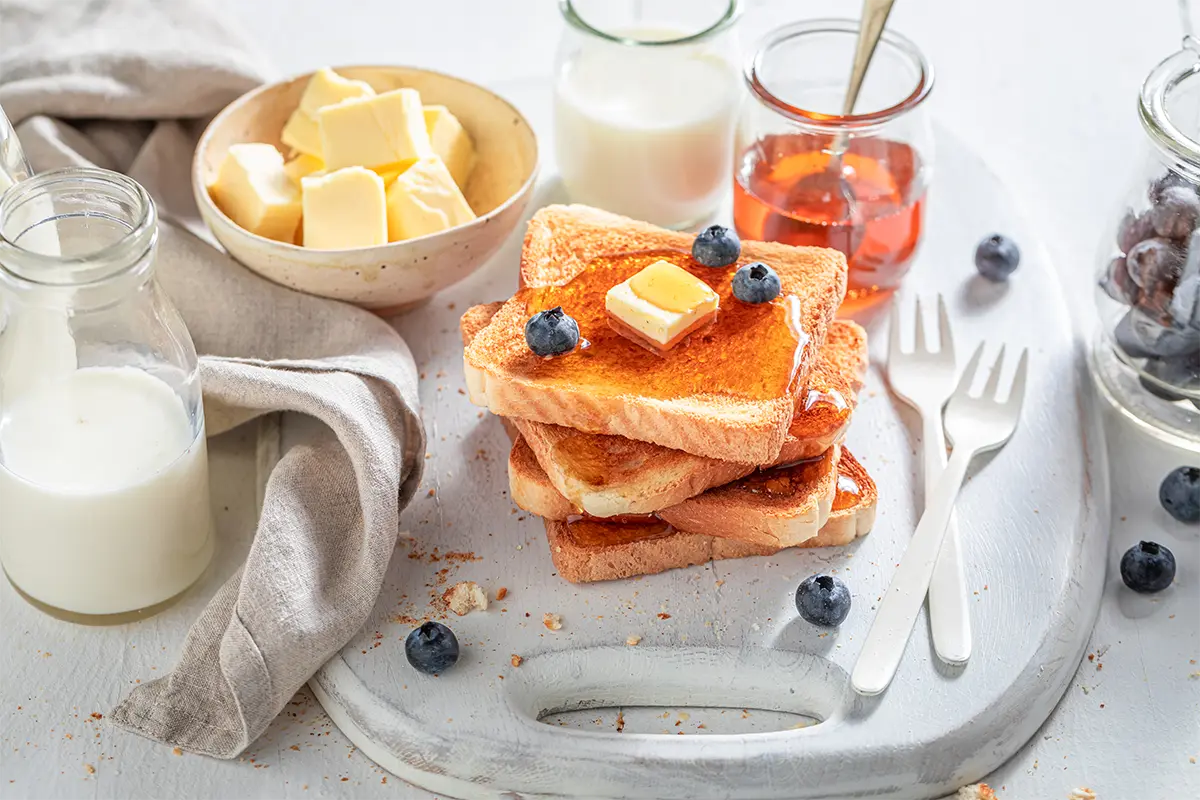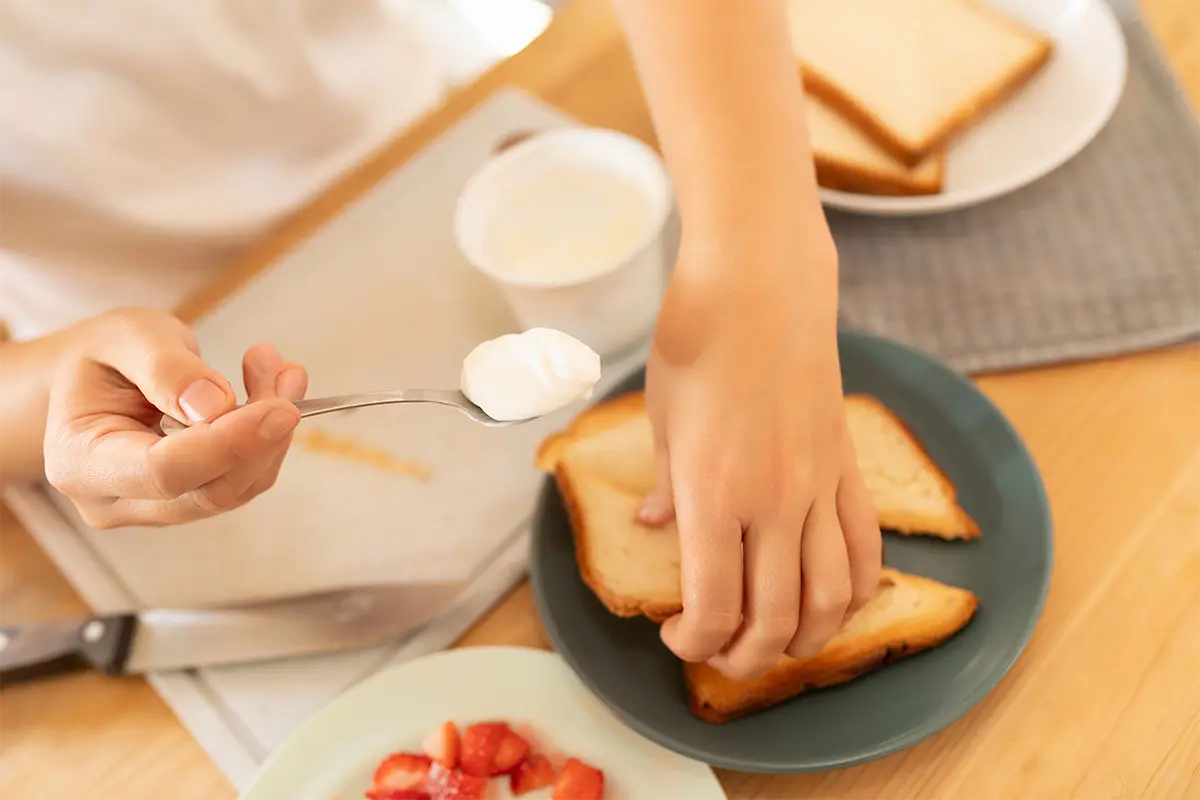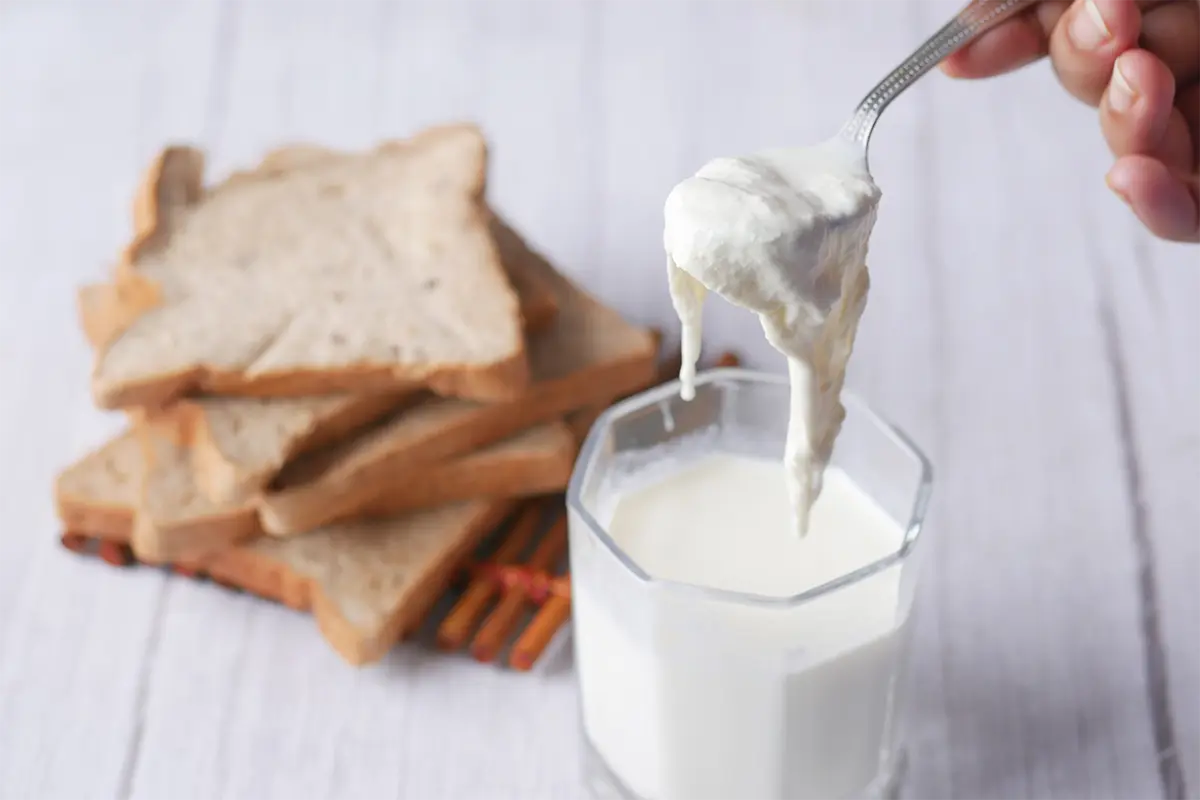The Ultimate Breakfast Debate: Heavy Cream or Milk for French Toast?
Thinking about French toast brings to mind its golden crust and custardy center. But before dipping your bread, you face a choice: heavy cream or milk? This question divides kitchens worldwide.
This debate isn’t trivial; it’s a significant breakfast battle. Advocates for heavy cream love its richness, making French toast a luxury. Milk supporters prefer a lighter, fluffier result.
Nutrition also plays a role. Milk suits calorie counters, while heavy cream is for indulgent days.
So, what’s better? The choice between milk and heavy cream adds drama to French toast making. We’re here to guide you through this dairy dilemma. Whether you prefer heavy cream’s richness or milk’s subtlety, it’s about what satisfies your craving.
Ultimately, trying both might lead to delightful discoveries. Remember, whether it’s milk or heavy cream, the love you add is what truly counts. Why not experiment and see which wins your heart? After all, breakfast is key, and your French toast should be spectacular.
The Foundation of French Toast
Choosing the Right Bread for French Toast
When it comes to French toast, not just any bread will do. The secret? Stale bread. Yes, that’s right. Stale bread isn’t just for the birds; it’s the golden ticket to perfect French toast. Here’s why: as bread ages, it dries out, becoming a sponge ready to soak up all that eggy goodness without falling apart. This means every bite is moist and flavorful, not soggy.
So, what types of bread should you use? First off, Texas toast is a top pick. Its thickness ensures a custardy interior and a crisp exterior. Then, there’s challah, a Jewish braided bread that’s slightly sweet and beautifully soaks up the egg mixture. Brioche, with its buttery richness, turns each slice into a decadent delight.
Moreover, while we’re focusing on these breads, don’t be afraid to experiment. Part of the joy of cooking is discovering what works best for you. Whether it’s Texas toast, challah, or brioche, the key is letting the bread go stale. This way, it’ll be ready to absorb all the flavors you throw at it, creating a French toast that’s nothing short of sublime.
In summary, the bread base of your French toast isn’t just a detail; it’s the foundation that sets the stage for culinary magic. By choosing the right kind and letting it age gracefully, you’re on your way to a breakfast masterpiece. So next time, think twice before tossing that day-old loaf. It could be your ticket to the best French toast ever.
The Dairy Debate

The Role of Dairy in French Toast
In the world of French toast, dairy plays a starring role. But, the choice between milk and heavy cream can make or break your breakfast masterpiece. Let’s dive in.
Milk in French Toast
Opting for milk brings a lighter touch to your French toast. It’s less about indulgence and more about enjoying a guilt-free morning treat. Milk keeps the batter thin, ensuring your toast is fluffy and soft. Plus, it’s the lower-fat option. So, for those watching their intake, milk is the way to go. It balances richness with restraint, letting the flavors of your bread and toppings shine.
Heavy Cream’s Richness
Now, for the heavy cream enthusiasts. This choice is all about luxury. Heavy cream transforms your French toast into a rich, dense feast. Its thick consistency coats the bread beautifully, creating a melt-in-your-mouth texture that’s hard to resist. Yes, it’s more calorific, but sometimes, breakfast needs that extra bit of joy. Heavy cream doesn’t just add flavor; it turns your dish into an experience.
So, where do you stand in the dairy debate? Whether you lean towards the lightness of milk or the decadence of heavy cream, both paths lead to delicious destinations. The choice affects texture, flavor, and nutrition, making it a key part of your French toast journey. Experiment, taste, and find your perfect match. After all, the best part of cooking is making it your own.
Combining Ingredients for Perfection
Crafting the Perfect Egg Mixture
The secret to exceptional French toast starts with the egg mixture. Let’s dive into mastering this foundational step.
Finding the Right Egg-to-Dairy Ratio
Firstly, the egg-to-dairy ratio is crucial. If you add too much dairy, your French toast might end up soggy; too little, and it lacks that delightful lushness. Striking the perfect balance enhances the eggs’ richness while allowing the dairy to add its creamy texture.
Adding Flavor Enhancers
Then, we move on to the flavor enhancers. Sprinkling sugar not only sweetens the mixture but also aids in achieving that gorgeous golden crust through caramelization. Vanilla extract introduces a layer of subtle sophistication, whereas cinnamon brings a cozy warmth to each bite. These ingredients work together, each playing a critical role in elevating the dish to new heights.
In summary, combining these components skillfully is akin to orchestrating a symphony. It involves careful balancing and harmonizing of flavors—from the eggs and dairy to the sugar and spices. So, arm yourself with a whisk, mix with purpose, and pour with love. By doing so, you’ll create French toast that not only looks golden and tempting but also sings with flavor in every bite.
The Cooking Process
Techniques for the Perfect Cook
Mastering the cooking process is key to creating unforgettable French toast. Let’s explore the best techniques.
Skillet vs. Griddle Cooking
Choosing between a skillet and a griddle? Each offers unique benefits. A skillet, for example, provides excellent heat retention and is ideal for cooking individual slices to perfection. On the other hand, a griddle allows for cooking multiple slices simultaneously, making it perfect for feeding a crowd quickly. Both require a medium heat setting to ensure even cooking without burning.
Achieving the Golden Brown Finish
French Toast Techniques: For that coveted golden brown finish, timing and temperature are everything. Regardless of whether you use a skillet or a griddle, keep the heat consistent. Not too hot, or the outside burns before the inside cooks. A little butter or oil goes a long way in creating a non-stick surface and adding a subtle flavor. Watch for the edges to crisp and the surface to turn golden, which usually takes about 2-3 minutes per side. Flipping at the right moment is crucial; too soon and you lose that crispness, too late and it might char.
In conclusion, the path to perfect French toast involves careful attention to detail, from selecting the right cooking surface to managing the heat. Whether you prefer the convenience of a griddle or the traditional touch of a skillet, mastering these techniques ensures a delicious outcome every time. So, experiment, find what works best for you, and enjoy the process of cooking up breakfast magic.
Nutritional Considerations
Caloric and Nutritional Comparison
French Toast Techniques: When crafting French toast, considering the calories and nutrition is as important as perfecting its taste. Let’s delve into these aspects.
Choosing between milk and heavy cream significantly affects the dish’s caloric intake. Milk, especially if you opt for skim or 2%, offers a way to enjoy French toast without overindulging in calories. It keeps the dish lighter and more suitable for those mindful of their diet.
Heavy cream, while delicious, ramps up the calorie count and fat content. It transforms the toast into a richer, more indulgent meal. For those special mornings or when craving comfort food, it’s a perfect choice. However, it’s wise to enjoy it in moderation.
Health considerations also play a role. Incorporating whole grains by selecting whole wheat or multigrain bread can boost fiber intake, making the meal more balanced. Adding fruits as toppings instead of syrup can also reduce sugar intake while enhancing the dish with vitamins and antioxidants.
In essence, the nutritional content of French toast varies based on your choices of dairy and bread. By making informed decisions, you can tailor the dish to fit your dietary needs without sacrificing flavor. Whether you’re indulging in a creamy delight or opting for a lighter version, you can enjoy French toast in a way that aligns with your health goals.
Recipe and Tips

The Ultimate French Toast Techniques Recipes
French Toast Techniques: Creating the ultimate French toast involves a blend of heavy cream and milk for the perfect balance of richness and lightness. Here’s how to make it.
Ingredients and Directions
Ingredients:
- 4 slices of thick-cut bread (Texas toast, challah, or brioche)
- 2 large eggs
- 1/4 cup heavy cream
- 1/4 cup milk
- 1 tablespoon sugar
- 1 teaspoon vanilla extract
- 1/2 teaspoon cinnamon
- Butter for frying
- Maple syrup and fresh berries for serving
Directions:
- Whisk together eggs, heavy cream, milk, sugar, vanilla extract, and cinnamon in a bowl.
- Heat a skillet or griddle over medium heat and melt a bit of butter.
- Dip bread slices into the egg mixture, letting them soak for a few seconds on each side.
- Fry each slice until golden brown, about 2-3 minutes per side.
- Serve hot with maple syrup and fresh berries.
This recipe marries the creaminess of heavy cream with the lightness of milk, ensuring each bite is perfectly balanced.
Tips for Perfect French Toast Every Time
For the best French toast, consider the following tips:
- Bread Choice: Opt for thicker slices like Texas toast, challah, or brioche. These types hold up well to soaking and cooking, offering a tender inside and crisp outside.
- Soaking Time: Don’t rush the soaking. Give the bread enough time to absorb the egg mixture without becoming soggy. A few seconds on each side should do.
- Cooking: Keep the heat at medium. It cooks the toast evenly without burning. If you’re using a skillet, cook one or two slices at a time to not overcrowd the pan.
- Serving: Serve French toast hot from the skillet. Top it with maple syrup, fresh berries, or a dusting of powdered sugar for extra flavor.
By following these tips and the recipe above, you’ll create a French toast that’s a hit with everyone. Whether it’s a special weekend breakfast or a comforting treat, this dish is sure to delight.
FAQs
Answering Your French Toast Questions
Navigating the delicious world of French toast, you might have questions. Let’s tackle some common ones.
Can I use non-dairy alternatives effectively?
Absolutely! Almond, soy, and oat milks are great options. They each bring a unique flavor and keep the dish lighter. Just remember, the thicker the non-dairy milk, the creamier your French toast.
How do I prevent my French toast from becoming soggy?
The key is in the bread choice and soaking time. Go for thicker, staler bread that absorbs the egg mixture well without getting mushy. Also, a quick dip is all you need. Letting the bread sit too long in the mixture is a common pitfall.
What toppings and syrups complement French toast the best?
Maple syrup is classic, but don’t stop there. Fresh berries, whipped cream, or a sprinkle of powdered sugar can add a delightful touch. For a twist, try caramel sauce or nut butters. They offer a rich flavor that pairs wonderfully with the toast’s soft texture.
By keeping these tips in mind, you’ll enhance your French toast experience. Whether you’re exploring non-dairy options, aiming for the perfect texture, or experimenting with toppings, there’s always a way to make your French toast even more special.
Making Your Choice: Heavy Cream or Milk?
Heavy Cream vs. Milk in French Toast
French Toast Techniques: Choosing between heavy cream and milk for French toast influences its texture and taste. Heavy cream adds a luxurious, velvety richness, perfect for an indulgent meal, enhancing flavors with its creamy consistency. Milk provides a lighter option, maintaining the bread’s delicate texture and letting toppings shine, suitable for everyday dining and offering flexibility with various types including non-dairy alternatives.
French toast is about personal preference and creativity. Whether opting for the indulgence of heavy cream or the simplicity of milk, the key is customization. Experiment with different breads, milks, and toppings to craft your ideal version. The journey to your perfect French toast is a personal exploration, blending culinary creativity with individual taste for a uniquely satisfying experience.
LSI and NLP Keywords:
- French toast recipes, best dairy for French toast, French toast cooking techniques, stale bread, skillet vs. griddle, nutritional content of French toast, breakfast ideas, creamy vs. light French toast, egg mixture for French toast, French toast toppings.
External Links:
- The Science of Cooking Eggs – Anchor Text: Understanding Egg Cookery
- Nutritional Benefits of Dairy – Anchor Text: Health Considerations in Dairy Choices
- History of French Toast – Anchor Text: The Origins of French Toast

